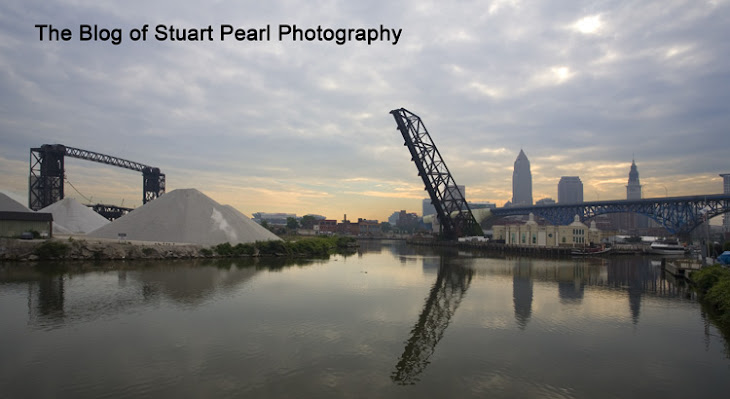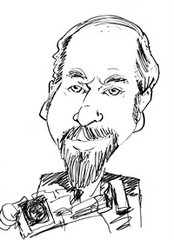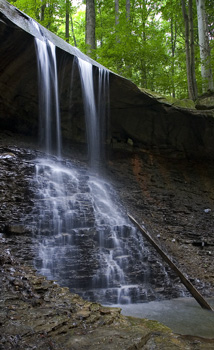© Stuart Pearl 2011 - Click on Images to Enlarge
Welders are fascinating to watch. They create their own constellation of stars that appear to swarm like a cloud of angry fireflies. They can cut steel or join beams. It all depends upon the task at hand.
This steelworker is cutting sheet pile. Unlike the Super "H" piles which are driven down to bedrock and form the base of the bridge piers on the Innerbelt project, sheet pile is used to hold back earth in areas that may become unstable.
According to the Project Team: "We use them as a sort of temporary retaining wall when soil conditions or the terrain makes it difficult to dig our traditional excavation for the pile driving and footer construction. Each piece of sheet pile is driven into the soil with the long edge overlapping the previous pile."
 |
Sheet pile stacked near bluffs overlooking Pier 10 construction of Westbound bridge
|
Here the sheet pile has already been driven into the softer earth at Canal Road. Steelworkers are cutting them to the desired height. By contrast, the Super H piles have a much different look.
The super " H " piles used here are the largest ever used for a project of this nature. When construction is finished, 20 miles of piling will have been used for the new Westbound bridge.
As a kid one of my favorite toys was the "Kenner Girder & Panel Building Set." It had small plastic pieces just like the "H' piles. We called them "I" beams and you could assemble a wide variety of bridges and buildings with the kit.
Here a steelworker is grinding the top of an " H " pile. It has already been driven into the pit that will be the base of Pier #6. The ends (tops) of these piles must be flat when additional piles are welded onto them. Each pile will then be a continuous piece measuring approximately 175 - 200' in length all the way down to bedrock.
Above is Pier #9 at W 3rd St. on September 16. Steelworkers are finishing the rebar work inside the cage atop both legs of the pier. Once the rebar insertion is completed, concrete is pumped into the top cap. The steel comprising this top cap weighs 217,000lbs. It will hold 1100 yards of concrete.
In this September 16 photo concrete is being pumped into the top of the leg that will form one side of Pier #8. The exposed rebar will eventually hook into the "top cap" portion of the structure.
Looking out from the bluffs near the Fireman's Museum you can see a clear view of the bridge piers taking shape in the Flats valley. Pier #9 at W. 3rd St. still "wears" its top cap insulating blankets in this October 7 photograph. Those blankets help keep the concrete temperature even as it cools after being poured. If it gives off heat too quickly it won't cure properly and strength will be lost.
This view from the Hope Memorial bridge shows Piers 9, 8 and 7 in their various stages of construction. Nine is the furthest along, and you can see the "H" piles being driven for the base of Pier seven at the far right.
A forest of " H " piles seems to rise from the site of the old Marathon gas station adjacent to the fireman's museum. As each pile is welded to the length before it, the pile driver hammers it down towards bedrock. At this location that point is 200 - 225" deep.
Standing at the site while the pile driver is working is quite an experience. Without earplugs the sound is unbearable. Fortunately I keep some in the car for this purpose. At a distance of 50' you can feel the earth reverberating up your entire torso with every strike.
Measurements are marked off on the " H " piles so the steelworkers know how far each has been driven into the ground.
The insulation jackets have been removed from Pier 9 in this October 28 picture. The concrete has cured sufficiently to allow removal of the side forms comprising the top cap. Only the center piece remains.
November 4, 2011 - Both legs and the center top cap of Pier 9 are now fully visible. This is the first major above ground structure of the West bound bridge to be nearly complete. Small decorative indentations called "reveals" can be seen at the top of the pier.

Driving along Canal Road you can see what 50+ years of weather have done to the piers of the current Innerbelt bridge.
The Lorain Carnegie Bridge (Hope Memorial) lands on the east bank quite close to where the new West bound bridge will touch down. Here the early morning light is washing across its white columns.
Rebar is critical for adding strength to the poured concrete. Much of it is assembled on the concrete pier pads and in the legs. But a lot of it is also "woven" on the ground prior to insertion in the forms. The steelworkers can work with the rebar anywhere. But having room to work on the ground is safer and much faster in some instances.
After the necessary rebar patterns have been assembled on their frames, cranes lift them into place. The steelworkers then wire them together and attach then to the pier legs.
This view is from the west bank slope near the former site of Cleveland Cold Storage. It was taken on November 21. Just left of center you can see the two legs that will comprise Pier #5. The Norfolk & Southern rail trestle is at the left.
Welding continues everywhere within the project. On the West bank not far from the University Inn, workmen are reinforcing the river bulkheads with a variant of sheet pile.
This slope had been a problem over the years. Not only did it push against the bulkheads, but it placed pressure on the piers of the current Innerbelt bridge. Here they are using a type of crane mounted vibrating pile driver.
I watched in fascination as the McKee Sons bulk carrier was pulled backwards by a river tug. Two welders did their work as the bow swung closer and closer to their scaffolding.
I don't know if they were aware how close the freighter passed. From where I stood it appeared not more than 25 feet.
The current Innerbelt bridge will remain standing for a couple more years. Traffic will be moved to the new Westbound bridge once that new structure is completed in the Fall of 2013. But walking amongst its old concrete piers still affords interesting views of the Flats.
* My thanks and appreciation to the Innerbelt Bridge Project Team for providing much of the technical information found in these articles.












































2 comments:
The pictures are fabulous, and the narrative is even more so. What a great documentation your series of blogs are!
Holds my interest as usual Stuart.
Post a Comment